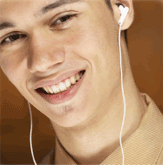
Crank It Down

Your mother was right when she told you to turn down the volume. Too much noise can permanently damage your hearing. No matter how old or young you are, and no matter whether it’s loud music coming from an MP3 player, the sudden blast of a hunting rifle, or the roar of a lawn mower, exposure to loud sounds can be harmful.
Noise-induced hearing loss (NIHL) is a serious problem. Some 30 million Americans are at risk for NIHL in the workplace, in recreational settings, and at home. In fact, it is the most common work-related disorder. Already 22 million Americans between the ages of 20 and 69 have permanently damaged their hearing by exposure to loud sounds or noise in their environment. Research also is finding an ever-increasing number of young people who are experiencing hearing loss to the same degree as that typically found in older adults.
When you think about noise, remember this: How loud? How close? How long? The blast of a firecracker experienced at close range can damage hearing permanently in an instant. Repeated exposures to noises from engines and machines such as motorcycles can erode hearing more slowly and so can long hours spent listening to loud portable music players.
If you are a construction worker, farmer, factory worker or airline employee, harmful sounds may be a regular part of your job. Harmful noises at home include those from vacuum cleaners, gas-powered lawn mowers, leaf blowers, and shop tools. Some noisy recreational activities include target shooting and hunting, snowmobiling, go-cart riding, woodworking, and playing certain computer games. Even some children’s toys have been found to produce sounds in the danger zone.
How loud is too loud? Prolonged exposure to sounds louder than 85 decibels (dB) can cause gradual hearing loss. A decibel is a unit that measures the intensity of sound. The predominant range of human hearing is represented on a scale from zero to 140 dB. A normal conversation is about 60 dB. Many personal stereo systems played at maximum volume are over 100 dB. Rock concerts and firecrackers can be 140 dB and higher.
NIHL is 100 percent preventable, but once it happens, the hearing loss can be permanent.
NIHL usually happens slowly and there is no pain. Right after exposure to noise, you may notice some “ringing” in your ears. You might have trouble hearing people talk. After several hours or even a few days, these symptoms may go away. However when you are exposed to loud noise repeatedly, you could have hearing loss that lasts forever.
How does NIHL cause damage to hearing? Exposure to loud sounds can damage or destroy the inner ear’s sensory hair cells. Once damaged, hair cells cannot grow back on their own. Scientists once believed that NIHL damages the hair cells by the pure force of the loud sound vibrations. Recent studies, however, have found that exposure to loud noise triggers the formation of free radicals--molecules that cause damage to cells and are known to kill hair cells. Scientists supported by NIDCD have demonstrated that antioxidants, such as aspirin and vitamin E, when given as long as three days after noise exposure can protect against the damage caused by free radicals and significantly reduce hearing loss in guinea pigs. Research is needed to determine if similar results can be obtained in humans.
NIDCD-supported researchers also have learned that gene therapy may one day be used to help restore lost hearing. Gene therapy is the addition or deletion of genes, in this case those that are involved in the regrowth of hair cells. Gene therapy was found to restore hearing in animals that had been deafened by drugs that damage the inner ear. These and other efforts bring scientists closer to the development of new ways to prevent and treat hearing loss.
What can you do to prevent NIHL? All individuals should understand the hazards of noise and how to practice good hearing health in everyday life. As parents you can encourage your children to wear hearing protection in noisy environments. You also can set a good example by turning down the volume levels on all household noise sources, and by wearing hearing protection when you mow the lawn, vacuum the house, blow dry your hair, or operate power tools.
If you buy your children an MP3 player, take the time to show them how to protect their hearing from permanent damage (Some researchers suggest that the volume should be no higher than 60 percent of the maximum and listening time should be limited to no more than one hour a day.)
The good news is that you can make “hearing health” a part of your lifestyle. Know which noises are harmful and carry ear protection with you. It’s up to you to prevent noise-induced hearing loss.
You Can Protect Your Hearing!
- Know which noises can cause damage.
- Wear earplugs, earmuffs, or other protective devices when involved in a loud activity.
- Teach your children to lower the volume on their portable music players and to limit listening time.
- Be alert to hazardous noise in the environment.
- Protect children who are too young to protect themselves.
- Tell family, friends, and colleagues about the hazards of noise.
- If you think you have a hearing loss, see your doctor. He or she may refer you to an otolaryngologist, or a physician who specializes in diseases of the ears, nose, and throat, or to an audiologist, who will perform a hearing test to assess the type and degree of loss.
Top